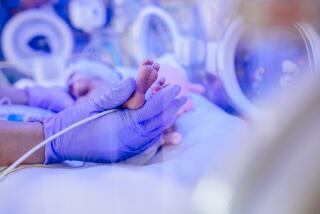Sweating, SIDS Connection Explored
- Share via
Excess sweating by an infant during periods of heavy sleep may be an indication the child could be at risk of Sudden Infant Death Syndrome, one of the most tragic mysteries of early childhood.
The theory that there is a link between heavy perspiration during periods of non-rapid eye-movement sleep--a deeper variety than rapid eye movement (REM) sleep in which dreams commonly occur--and Sudden Infant Death Syndrome was initially proposed in 1984 by Belgian researchers.
Now, the same team at the Free University of Brussels has published results of a later study in which normal infants, unaffected siblings of SIDS victims and babies who had survived close calls with SIDS were closely observed as they slept. The tests involved a total of 258 children who were each observed during a full 12-hour night.
Reporting in the journal Pediatrics, the Belgian team said sweating was neither profuse nor significant in any of the three groups of infants during REM sleep. All of the youngsters in the new study were between 10 and 16 weeks old.
But during non-rapid eye-movement sleep--sometimes called NREM--youngsters who had survived previous life-threatening situations were observed to sweat profusely. Sweat evaporated on the foreheads of the survivors of life-threatening episodes at nearly twice the rate of other children. During waking hours and periods of REM sleep, the three groups perspired at about the same levels.
The Belgian team could not explain the difference in perspiration, but the researchers concluded the sweating habits during NREM sleep “could contribute to risk prediction for SIDS.” The excessive perspiration was likened by the Belgian team to the profuse sweating common among obese adults.
Bartender Intervention
Bartenders trained to control drinking of inebriated patrons can apparently measurably reduce the blood alcohol content of their customers through such techniques as checking proof of age, stalling on serving up new rounds, commenting on the haste with which someone is drinking, and offering food and water to the customer.
These observations by a team at Virginia Polytechnic Institute and State University in Blacksburg, Va., may mean, the researchers concluded, that expanded bartender and cocktail waiter- and waitress-intervention training has the potential to reduce drunken driving.
In the study, psychologists conducting the research project sent trained research assistants into two local bars where they acted like regular customers and tested the performance of 17 waiters and waitresses. About half the servers had been trained in intervention techniques. The visits occurred in the late evenings on Thursday, Friday and Saturday nights, according to an article reporting results in the American Journal of Public Health.
The phony customers, who were wired for sound recording, deliberately consumed three or four drinks an hour for two consecutive hours, consuming enough to likely become drunk. As the pseudo-customer drank, a tape recorder tracked the attempts made by servers to discourage drunkenness.
When the pseudo-customer left the bar, his or her blood alcohol level was measured. Phony customers served by untrained service personnel had blood alcohol levels averaging over the .10% that is widely accepted as the threshold of drunk driving. Trained servers produced patrons with only about half that level of alcohol in their bloodstreams.




